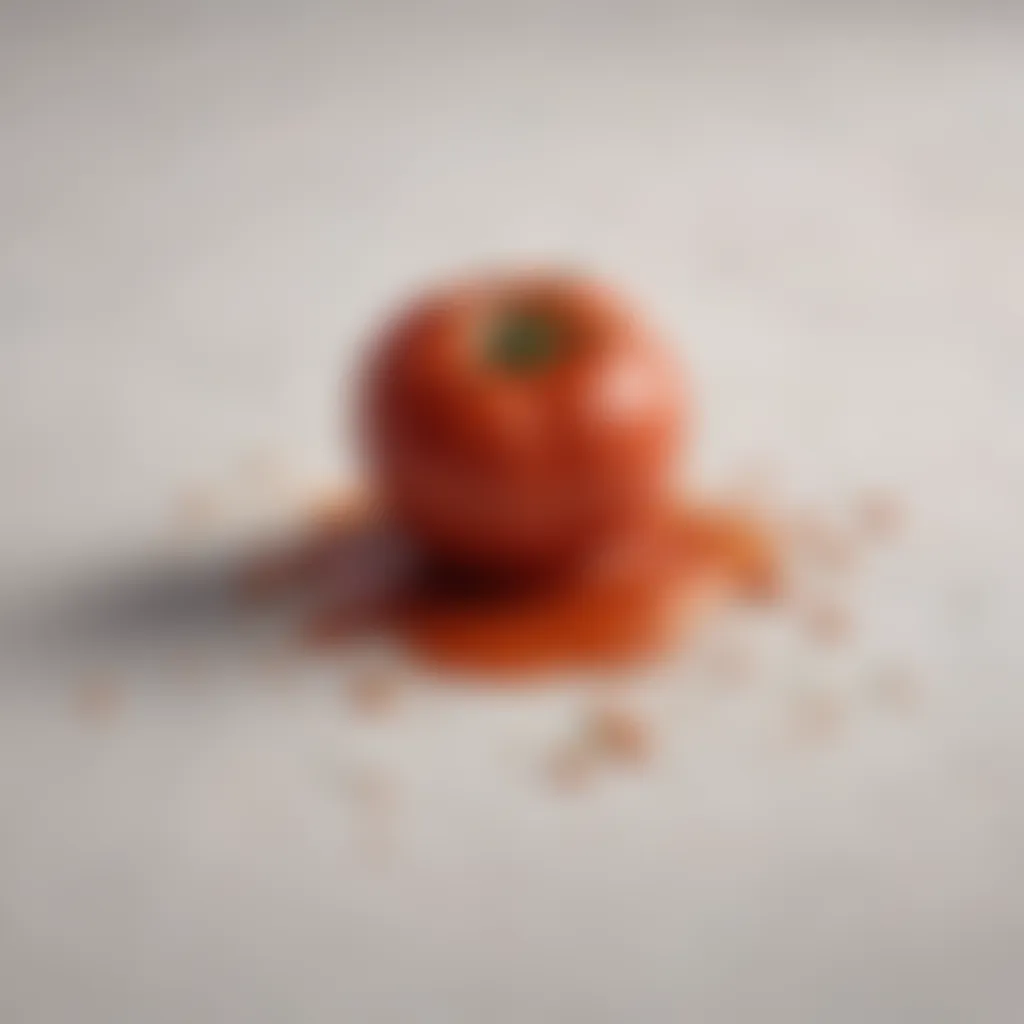Expert Tips for Eliminating Tomato Sauce Stains


Intro
Tomato sauce is a delightful companion to many dishes, but it can be quite a menace to white shirts. The vibrant red color of the sauce, paired with its oily nature, poses significant challenges for effective stain removal. Understanding how to address this common household issue can save fabric and foster confidence in handling fabric care. In this guide, we will provide practical strategies to eliminate tomato sauce stains from white shirts without risking damage. We will delve into various methods, explore suitable cleaning agents, and offer clear, actionable steps.
Ingredients:
To start the stain removal process effectively, prepare the following items:
- Cold water (as needed)
- Liquid dish soap, such as Dawn, about 2 tablespoons
- White vinegar, about 1 tablespoon
- Baking soda, about 1 tablespoon
- Soft-bristled brush or old toothbrush
- Clean, white cloth (for blotting)
- Laundry detergent (your preferred brand)
- Access to washing machine
Preparation Steps:
- Immediate Action: As soon as you notice the stain, gently blot it with a clean cloth. This will help absorb excess sauce. Avoid rubbing, as it may push the sauce deeper into the fabric.
- Rinse with Cold Water: Hold the stained area under cold running water. This helps to dilute the sauce, pushing it out of the fabric fibers. Stop rinsing when the water runs mostly clear.
- Mix Cleaning Solution: In a small bowl, combine the 2 tablespoons of liquid dish soap with 1 tablespoon of white vinegar. Stir well until mixed completely.
- Apply the Solution: Using a clean cloth or sponge, apply the mixture to the stain. Make sure to cover the stain entirely. Allow it to sit for at least 5 to 10 minutes.
Technical Aspects:
When treating stains, attention to temperature and timing is crucial:
- Water Temperature: Always use cold water, as hot water can set the stain.
- Timing: Allow the cleaning solution to sit for at least 5 to 10 minutes for best results. Longer times may help with older or set stains.
Cooking Process:
- After the 10-minute wait, gently blot the stained area using a clean, white cloth. Repeat process if necessary until you notice a reduction in the stain's appearance.
- Next, sprinkle about 1 tablespoon of baking soda over the stain. The reaction with vinegar will help lift the remaining stain. Gently scrub this mixture with a soft-bristled brush.
- Allow this paste to sit for another 10 minutes.
- Rinse thoroughly with cold water, ensuring all residues are washed away.
- Final Wash: Wash the white shirt in your washing machine using your preferred laundry detergent. Refer to care label for specific settings. Cold water wash is typically recommended for white fabrics to avoid yellowing.
Troubleshooting Tips:
If the stain persists after the first wash, consider the following suggestions:
- Re-apply Cleaning Solution: Repeat the soaking process and let it sit a bit longer.
- Check Underneath: Be sure to turn the shirt inside out when treating the stain to prevent it from setting further.
- Avoid Heat: Do not dry the shirt until you are sure the stain is gone, as heat from the dryer can permanently set the stain.
Remember, patience is key when dealing with stubborn stains. The right combination of techniques and products will yield successful results.
Understanding the Challenge of Stains
Removing stains from clothing can be a frustrating task, especially when it comes to a stubborn substance like tomato sauce. Understanding the challenge of stains is essential for anyone who seeks to maintain the pristine appearance of their garments. This knowledge helps in selecting the appropriate cleaning strategies while also minimizing damage to the fabric. Each stain type requires a unique approach based on factors like composition, severity, and fabric material, which are critical in formulating effective stain removal techniques.
The Nature of Tomato Sauce Stains
Tomato sauce stains are particularly troublesome due to their oil and pigment content. The combination of these two elements not only allows the sauce to adhere firmly to the fabric but also poses a colorful challenge for stain removal. When tomato sauce spills occur, the natural acidity of tomatoes can also lead to a chemical reaction that affixes the color more deeply into the fibers. Understanding this chemical behavior is vital in addressing the stain effectively.
The color from tomato sauce can penetrate fabrics quickly, especially if left untreated. The longer the stain remains, the more difficult it becomes to remove. Therefore, quick action is not only beneficial but often necessary. Knowing that the sauce consists of materials like tomatoes, oils, and various spices can inform the choice of cleaning agents. Some cleaners are more effective at breaking down oil, while others are better suited for pigments like those found in tomato sauce.
Impact of Fabrics on Stain Removal
The type of fabric plays a critical role in the effectiveness of stain removal techniques. Different materials react differently to stains and cleaning agents. For example, cotton tends to be more absorbent, meaning that it might hold a tomato sauce stain more stubbornly than synthetic fibers. Conversely, synthetic fibers such as polyester may allow for easier removal due to their less absorbent nature.


Furthermore, fabrics have varying tolerance levels to heat and chemical exposure. Certain stain removers can cause some fabrics to degrade, change color, or lose texture. Recognizing the fabric type can significantly enhance the strategy for stain removal. For instance, delicate fabrics like silk may require milder treatment options compared to more robust fabrics such as denim.
In summary, understanding both the nature of tomato sauce stains and the impact of fabric properties is foundational for effective stain removal strategies. This knowledge sets the stage for subsequent actions needed to restore white shirts to their original condition.
Immediate Actions to Take
Tomato sauce stains present a unique challenge, particularly on white shirts. Taking immediate actions is crucial in minimizing the damage. Once the stain happens, a swift response can determine whether the stain is successfully removed or becomes a permanent blemish. It is vital to understand the best practices during the initial encounter with the stain. This section focuses on assessing the stain severity and employing rapid response techniques for effective stain management.
Assessing the Stain Severity
When faced with a tomato sauce stain, the first step involves assessing how deep and how fresh the stain is. This evaluation is important as it guides your subsequent actions. Fresh stains are generally easier to remove compared to dried ones. To assess the stain severity, observe the following:
- Time Factor: If the sauce is still wet, immediate action is needed.
- Color Intensity: Bright red stains indicate fresh encounters. Pale or dark stains signal more significant penetration and might require distinct strategies.
- Textile Type: Different fabrics react differently to stains. For instance, cotton might absorb the sauce more readily than polyester.
Knowing these factors will help formulate a perfect plan for remediation.
Rapid Response Techniques
In order to effectively manage tomato sauce stains, understanding the rapid response techniques is essential. These techniques can significantly impact the removal success.
Blotting instead of Rubbing
Blotting is a specific technique used right after the stain occurs. This method involves using a clean cloth or paper towel to gently lift the sauce off the fabric. The key characteristic of blotting is that it absorbs liquid, reducing the stain's spread. It is beneficial because:
- It minimizes the fabric's damage, keeping the fibers intact.
- It avoids pushing the sauce further into the textile, which can happen when rubbing.
- It is an easy method that anyone can implement quickly.
A unique feature of blotting is its ability to remove excess sauce without introducing more friction. However, care must be taken not to over-saturate the textile, as this may spread the stain instead of removing it.
Using Cold Water Efficiently
Employing cold water is a powerful strategy in the fight against tomato sauce stains. Cold water is known for its ability to prevent setting stains, which is imperative in stain removal. The key aspect of this technique is that it rinses the area without setting the stain further into the fabric. It is a popular choice due to a few reasons:
- Cold water is gentler on the fibers compared to hot water, reducing the risk of damage.
- It works effectively in preventing the sauce from embedding within the fabric.
The unique feature of using cold water is that it can be readily available and requires no additional ingredients. However, using cold water alone may not eliminate the stain entirely. It is best used in combination with blotting techniques for maximum effectiveness.
Quick Tip: Always remember to use clean and dry cloths when blotting. Dirty cloths can cause more stains.
Pre-treatment Options
Pre-treatment is a crucial step in the process of removing tomato sauce stains from white shirts. It directly influences the effectiveness of the subsequent cleaning methods. Immediately addressing the stain before launching into a full wash can significantly enhance the chance of complete removal. This stage often dictates whether the stain is destined for failure or success in cleaning.
When dealing with stubborn tomato sauce stains, applying pre-treatment options can save both time and effort later. The act of pre-treating can minimize the risk of setting the stain in, which is common if the fabric is washed without any prior attention. Ultimately, the choice of how to pre-treat a fabric depends on the resources at hand, the severity of the stain, and the fabric type.
Homemade Solutions
Baking Soda Paste


Baking soda paste is a well-regarded option for pre-treating tomato sauce stains. Its key characteristic is its ability to gently lift stains from fabrics without causing damage. This is particularly beneficial for white shirts, where fabric integrity must be maintained.
One unique feature of baking soda paste is its gritty texture, which helps act as a mild abrasive when mixed with water. This abrasiveness assists in breaking down the sauce components. An advantage of using baking soda is that it is widely available and environmentally friendly. However, its limitation lies in the fact that it may require a longer soaking time compared to commercial options.
White Vinegar Application
White vinegar is another effective homemade remedy for tomato sauce stains. Its key characteristic is its acid content, which can help break down the stain's components. The process of using white vinegar can also help neutralize odors that may linger after a spill.
A distinctive advantage of white vinegar is its dual-action capability: it works both as a stain remover and as a fabric softener. However, users must proceed with caution, as excessive heat during washing might render the vinegar less effective. Additionally, its strong smell can be off-putting for some, although this typically dissipates once the shirt is washed.
Commercial Stain Removers
Enzymatic Cleaners
Enzymatic cleaners are designed to tackle protein-based stains, like the ones found in tomato sauce. These cleaners contain enzymes that specifically target and break down such stains. Their key characteristic is their effectiveness at lifting stains from white fabric without excessive scrubbing. This makes them a beneficial choice when dealing with tough tomato sauce.
A unique feature of enzymatic cleaners is that they can penetrate deep into the fibers of the fabric, often leading to superior results. However, a disadvantage is that they may take longer to work compared to more aggressive cleaning agents. Additionally, not all fabrics are compatible with enzymatic solutions, which requires careful consideration before application.
Oxygen Bleach Alternatives
Oxygen bleach alternatives offer a safe and effective method for whitening and stain removal without the harshness of traditional bleach. Their key characteristic is their ability to brighten whites and eliminate discoloration caused by stains. These alternatives are typically safe for both colored and white fabrics.
The unique action of oxygen bleach involves the release of oxygen when mixed with water, which helps lift stains from fibers. This option is beneficial because it won't damage fabric integrity. However, it may not be as effective on old or deeply set stains, requiring multiple treatments for the best results.
Washing Techniques
Understanding how to effectively wash white shirts is crucial in the stain removal process, especially when dealing with persistent tomato sauce stains. The washing stage is not just about soaking fabric in water and detergent; it involves strategic decisions that can enhance or diminish the effectiveness of your previous stain removal efforts. Choosing the right washing techniques can make a significant difference in restoring your garment.
Selecting the Right Cycle
The washing cycle you select for your white shirt can greatly influence the outcome of stain removal. Different machines have specific settings designed for various fabric types and stain scenarios. For white cotton shirts, a regular cycle is often recommended. This cycle usually combines a robust agitation with adequate soaking time, which is essential for lifting stubborn stains.
- Light cycle: Suitable for delicate materials but may not effectively remove tomato sauce stains.
- Normal cycle: Ideal for most white cotton shirts, providing thorough cleaning without being too harsh.
- Heavy cycle: Best for heavily soiled items; however, it might cause more wear on the fabric over time.
Before starting the wash, ensure that your shirt is not too heavily soiled beyond just the stain. If there are multiple stains, treating each specifically may help.
Temperature Considerations
Temperature plays a vital role in the washing process. The way you handle the temperature settings can either enhance the effectiveness of your detergent or hinder the cleaning action. For tomato sauce stains on white shirts, cold to warm water is generally the best option.
- Cold water: Prevents the stain from setting deeper into the fabric and is a gentler approach. Using cold water helps in preserving the shirt's color, especially for white fabrics.
- Warm water: Once you've ensured the stain is manageable, gradually introducing warm water can help in breaking down the oils and sugars found in tomato sauce. A temperature around 30-40 degrees Celsius is often effective without compromising fabric integrity.
- Hot water: While it may seem tempting, using hot water can sometimes set stains instead of removing them. It’s generally not recommended unless dealing with heavily soiled items.
Important Note: Always check the care label on your white shirt before deciding on water temperature and washing cycle to avoid damaging the fabric.
By carefully selecting the washing cycle and managing water temperature, you not only increase your chances of removing tomato sauce stains but also help maintain the quality and longevity of your white shirts.
Post-treatment Inspection


After initiating the cleaning process, the post-treatment inspection is a crucial phase. This step focuses on evaluating the effectiveness of the stain removal techniques utilized on the tomato sauce stain. A thorough inspection helps to determine if the stain has been fully eradicated or if further action is needed. Ignoring this step can lead to persistent stains setting in, making future removal efforts significantly more challenging.
Assessing the Stain's Status
Once the washing cycle is complete, your first task is to examine the affected area. Hold the shirt up to a light source to view the stain clearly. If the stain remains visible, it indicates that the cleaning process did not fully succeed. Look for any discoloration or residue left behind by the sauce. If the fabric shows signs of the previous stain, do not dry the shirt. Heat can set the stain, making it practically impossible to remove later.
This assessment allows you to make informed decisions regarding the next steps. If you find that the stain is faded but still present, it means the pre-treatment methods were partially successful, offering a solid basis for further treatment. Conversely, a clearly visible stain suggests that a different approach may be needed.
Re-treating if Necessary
If the stain has not lifted completely, re-treatment is essential. Start by applying another round of the previously used cleaning solution or try a different product altogether. For example, if you initially chose baking soda paste, you could switch to commercial enzymatic cleaners for a more potent effect. Be sure to follow the instructions carefully to avoid damaging the fabric.
After applying your chosen method, allow it to sit for the recommended time. This time frame can greatly influence effectiveness, particularly with enzyme-based solutions that require time to work on proteins found in tomato sauce.
Once sufficient time has elapsed, re-evaluate the stain again. If it persists, you may consider more aggressive treatments, such as using oxygen bleach. However, always check fabric care labels to ensure compatibility before applying any harsh chemicals.
If the stain remains despite your efforts, consider consulting professional cleaners. They have the tools and expertise to tackle stubborn stains without risking damage to your garments.
In sum, the post-treatment inspection is your opportunity to scrutinize the results of your stain removal efforts. Proper assessment and timely re-treatment can help restore your white shirts to their original, unblemished state.
Long-term Care for White Shirts
Long-term care for white shirts is vital for maintaining their appearance and extending their life span. White shirts often represent a staple in many wardrobes, prized for their versatility and crisp look. However, without proper care, they can quickly become dingy or stained, losing their appeal. Understanding how to effectively care for your white shirts can save time, money, and frustration in the long run.
Preventive Measures
Taking preventive measures before stains occur can make all the difference. Here are some strategies to consider:
- Choose Quality Fabrics: Invest in white shirts made from durable fabrics. Natural fibers like cotton or specialized blends may resist stains better than lower-quality materials.
- Avoid Eating in Light Shirts: It might seem impractical, but minimizing the risk by avoiding meals where spills are likely can prevent stains.
- Use Stain-resistant Products: Consider treatment products that add a stain-repellent feature to your shirts. Brands like Scotchgard offer options that can make it easier to wipe away potential stains before they set.
- Store Properly: Fold or hang your white shirts neatly when not in use. Avoiding overcrowding in your wardrobe prevents creases and helps the fabric breathe.
"Stains are not just inevitable accidents; they can be avoided with a proactive approach."
Best Practices for Maintenance
To keep white shirts looking fresh over time, establishing good maintenance practices is essential. Follow these recommendations:
- Regular Washing: Wash white shirts regularly to prevent stains from settling in. Even if they don't look dirty, regular washing can prevent build-up.
- Temperature Control: Utilize hot water during washes, as it helps in removing odors and stains. However, check the fabric label to ensure this is safe for your shirt.
- Use the Right Detergent: Opt for a high-quality detergent designed for whites. Products like OxiClean or Tide's bleach alternative can brighten whites effectively.
- Avoid Fabric Softeners: Although fabric softeners may seem beneficial, they can leave a residue that dulls whites. Opt for dryer balls as a natural alternative.
- Drying Method: Air drying is preferable for white shirts. The sun's rays can help naturally whiten the fabric. If using a dryer, employ a low heat setting to prevent shrinking.
- Iron Carefully: When ironing, ensure that the shirt is damp or use steam. This approach prevents scorching and helps maintain a crisp, clean look.
Maintaining white shirts may require some extra effort, but the returns are worthwhile. By implementing preventive measures and adhering to best practices, your favorite white shirts will remain an essential part of your wardrobe for years.
Expert Recommendations
Expert recommendations often stem from years of experience and research. Consulting with fabric care professionals or stain removal experts can reveal less-known tips that are highly effective. For example, many experts advocate for using specific brands of stain removers like OxiClean or Zout that may yield better results compared to generic options. These products contain enzymes designed to tackle tough stains, making them a wise choice.
In addition, experts frequently suggest testing any treatment on a hidden area of the fabric first. This way, you avoid unexpected damage to the garment's fabric or color. Using a gentle blotting motion while applying cleaning agents is also a common recommendation. This technique minimizes the risk of spreading the stain, allowing for more effective removal.
Where to Find Further Information
For those seeking more information on this topic, several platforms can provide valuable insights. Websites like Wikipedia often have articles on common household issues, including tips for stain removal. These articles summarize essential details and can lead you to further reading.
Additionally, forums such as Reddit can be excellent resources. Community members share personal experiences and tips that may be more relatable than commercial advice. Engaging in discussions or simply browsing threads related to stain removal can give practical insights from a diverse group of individuals.
Finally, platforms like Facebook host groups dedicated to home care and stain removal, where members exchange ideas and solutions. These resources foster a community of support, allowing you to find tailored advice relevant to your specific fabric or stain concern.







